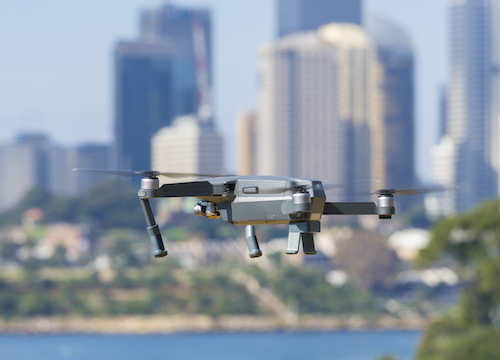In the first three parts of the series “Drones at Work,” we looked at how Unmanned Aircraft Systems (UAS) or drones are being used in industries such as agriculture, construction, and wildlife biology around the world. The final segment of this series discusses the role of drones in public safety.
The Federal Aviation Administration (FAA), among other government organizations, has recognized the breakthrough potential of drone technology. Private and government entities are already using drones and advanced imaging technologies to transform public safety.
Hazardous Material Field Assessment
When hazardous materials are leaked or spilled, first responders may find themselves in dangerous situations. Giving rescue workers and clean-up crews greater situational awareness is the best way to ensure their safety on the job.
Drones can assess dangerous areas by detecting hot spots invisible to the unaided eye using thermal imaging, night vision, and infrared camera systems. First responders can use this information to designate the perimeter of the HAZMAT zones for decontamination. Digital infrared thermal imaging can even spot civilians inside or near the HAZMAT zones.
Search and Rescue
The traditional method for conducting search and rescue (SAR) operations involves large groups of people physically walking an area and searching for people in distress or imminent danger and enacting rescue operations from the ground. With drone technology, first responders can search larger areas more efficiently and from a viewpoint that uncovers a lot more than the human eye can see.
Because of the high battery life (longer flight time) and digital infrared thermal imaging capabilities of high-quality drones, search and rescue teams can conduct long missions covering vast areas. Equipped with a special thermal camera, drones also allow search and rescue teams to do their job in low-light conditions. Law enforcement may deploy drones with similar capabilities when responding to an active shooter crisis, evacuation planning and protocols, forensic mapping/crime scene investigation, long-range surveillance, and crowd monitoring and management.
Medical Supply and Equipment Dispatch
When a natural disaster such as an earthquake or flooding occurs, getting emergency medical services, including first aid and trauma care products, to victims can save many lives. According to data from Norrtälje (Stockholm) in Sweden, drones can reach targets quickly and airdrop essential medical supplies promptly. Data suggests that using a drone instead of traditional emergency medical services (EMS) can save about 15 minutes, in an emergency, this could be the difference between life and death.
A drone can also be used to deploy an automated external defibrillator (AED). In an emergency, rescue teams can immediately fly to the scene of a medical emergency, deliver an AED using a drone, and direct emergency medical technicians (EMT) to the scene.
Ocean and Swiftwater Rescue
Delivering life jackets, vests, and personal flotation devices (PFD) to people at risk of drowning can save lives. However, people in need can sometimes be in places where they are difficult to get to quickly and safely. In these cases, having a drone capable of dropping PFDs can make a huge difference.
Drone manufacturers are now partnering with public safety, resource protection, and emergency services to create drone systems for delivering flotation devices to those in need. Drones enable rescuers to deliver life-saving medical equipment and supplies in minutes. Once the flotation device has been delivered safely, emergency responders can reach the person in need and bring them to safety.
Ice Rescue
According to Dr. Andreas Claesson (RN, EMT-P, Ph.D.) of the Journal of Emergency Medical Services (JEMS), drones could help in future ice and cold-water rescue by using digital infrared thermal imaging to clearly distinguish victims from the icy water, delivering life jacket/flotation device, and directing rescue crews to the victim.
Drones and their supporting technology are currently reshaping the public safety industry. The advantages of using drones include, but are not limited to, HAZMAT zone assessment, assistance in search and rescue missions, and medical supply and equipment dispatch. Whatever challenges the future may bring for public safety personnel, it is clear that drones will be employed to overcome those challenges and save lives. Consult with the engineers at Universe Optics to learn more about custom lenses designs for drones and other applications by calling 516.624.2444 or emailing info@universeoptics.com.